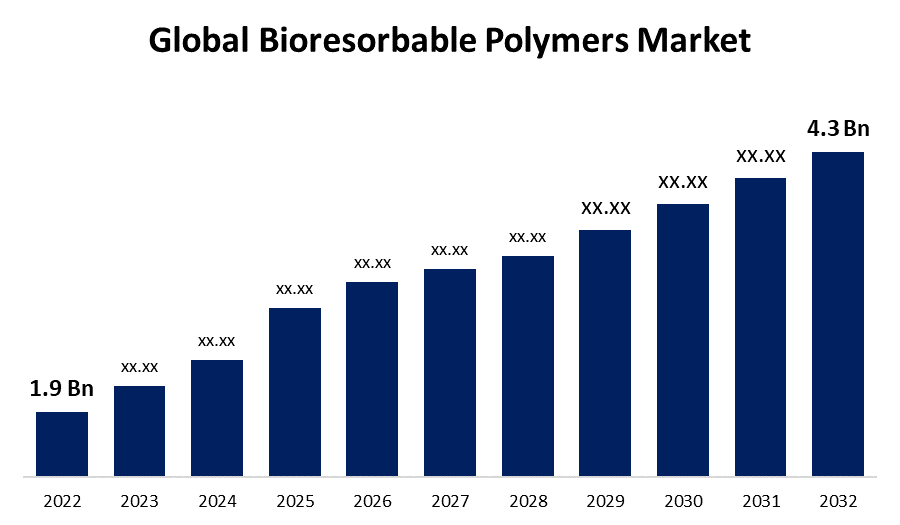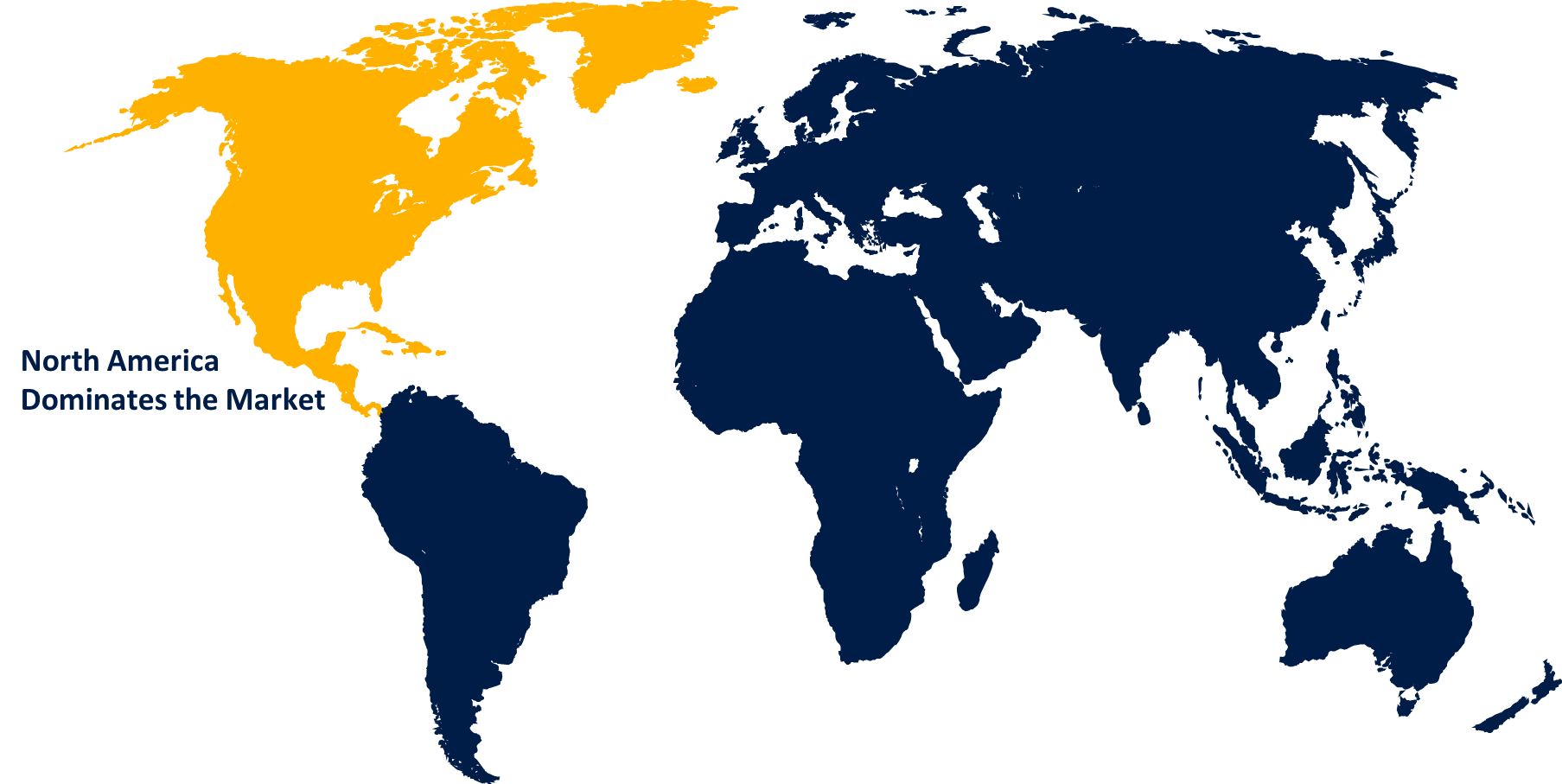Global Bioresorbable Polymers Market Size, Share, and COVID-19 Impact By Product (PLA, Proteins, Polyglycolic Acid), By Application (Drug Delivery, Orthopedics), by Region (North America, Europe, Asia-Pacific, Latin America, Middle East, and Africa), Analysis and Forecast 2022 – 2032
Industry: Chemicals & MaterialsGlobal Bioresorbable Polymers Market Size Insights Forecasts to 2032
- The Bioresorbable Polymers Market Size was valued at USD 1.9 Billion in 2022.
- The Market is Growing at a CAGR of 14.7% from 2022 to 2032
- The Worldwide Bioresorbable Polymers Market Size is expected to reach USD 4.3 Billion by 2032
- Asia Pacific is expected to grow the fastest during the forecast period.

Get more details on this report -
The Global Bioresorbable Polymers Market Size is expected to reach USD 4.3 Billion by 2032, at a CAGR of 14.7% during the forecast period 2022 to 2032.
Bioresorbable polymers, sometimes referred to as biodegradable polymers or resorbable polymers, are a type of substances that the body may gradually digest and break down. In numerous medical applications requiring transient structural support, drug administration, or tissue regeneration, these polymers are essential. As they do not require surgical removal after serving their original purpose, they have various advantages over non-resorbable materials. Polylactic acid (PLA), polyglycolic acid (PGA), poly(lactic-co-glycolic acid) (PLGA), and polycaprolactone (PCL) are typical bioresorbable polymers. These polymers are excellent for a variety of applications due to their mechanical characteristics and varied rates of degradation.
Impact of COVID-19 On Global Bioresorbable Polymers Market
Global supply chains were disrupted by the epidemic, which had an impact on the manufacture and delivery of a variety of commodities, including bioresorbable polymers. To give COVID-19 patients priority, many elective medical procedures were delayed or abandoned. This probably had an effect on the demand for medical equipment and supplies, particularly bioresorbable polymer-based ones. Bioresorbable polymers are used in critical applications like as tissue engineering, medication administration, and wound closure, all of which were necessary during the epidemic. The pandemic made healthcare infrastructure and readiness even more crucial, possibly spurring investment and innovation in medical supplies and technologies. The development of novel medical devices, presumably including those that use bioresorbable polymers, could be influenced by the shift towards remote healthcare services.
Global Bioresorbable Polymers Market Report Coverage
| Report Coverage | Details |
|---|---|
| Base Year: | 2022 |
| Market Size in 2022: | USD 1.9 Billion |
| Forecast Period: | 2022-2032 |
| Forecast Period CAGR 2022-2032 : | 14.7% |
| 2032 Value Projection: | USD 4.3 Billion |
| Historical Data for: | 2018-2021 |
| No. of Pages: | 200 |
| Tables, Charts & Figures: | 115 |
| Segments covered: | By Product, By Application, By Region and COVID-19 Impact analysis. |
| Companies covered:: | Corbion, Evonik Industries, Poly-Med Inc, KLS Martin Group, Foster Corporation, DURECT Corporation, Zeus, Ashland and other key vendors. |
| Pitfalls & Challenges: | COVID-19 Empact, Challenge, Future, Growth, & Analysis |
Get more details on this report -
Key Market Drivers
The creation of novel medical techniques and technologies utilising bioresorbable polymers was a factor in the market's expansion. These developments included uses for tissue engineering, medication delivery systems, orthopaedic implants, and cardiovascular devices. The demand for medical interventions, such as surgeries and implants, was being driven by an ageing worldwide population. This demographic was served by the use of bioresorbable polymers in a variety of orthopaedic and tissue healing applications. Due to their advantages in shortening patient recovery times and complications, bioresorbable polymers are frequently employed in minimally invasive procedures, which are gaining popularity. The demand for bioresorbable polymers in medical treatments increased as more patients and medical professionals learned about their advantages. Bioresorbable polymers' adaptability made them suitable for a variety of medicinal uses, which contributed to the rise of their industry.
Key Market Challenges
It can be difficult to strike the ideal balance between the polymer's rate of degradation and the healing or regeneration process it is intended to stimulate. If degradation occurs too quickly, structural integrity may be lost before tissue repair is finished. For medical applications, bioresorbable polymers must have uniform characteristics and performance throughout batches. Variability in material qualities can affect how well a device works and how patients fare. Due to the difficulty in formulating and manufacturing bioresorbable polymers, their development and production can be expensive. This may have an effect on their accessibility and affordability. It can be challenging to develop consistent and repeatable manufacturing procedures for bioresorbable polymers since these materials must have their degradation, mechanical properties, and biocompatibility under strict control.
Market Segmentation
Product Insights
Polylactic Acid (PLA)-based bioresorbable polymers segment is dominating the market over the forecast period
On the basis of product, the global bioresorbable polymer market is segmented into PLA, Proteins, Polyglycolic Acid. Among these, PLA segment is dominating the market over the forecast period. The biocompatibility of PLA has been thoroughly investigated, making it ideal for a variety of medicinal applications. Lactic acid and its derivatives, which are its degradation products, are naturally metabolised by the body. By varying its molecular weight, crystallinity, and stereochemistry, PLA can be made to exhibit different mechanical properties. Because of this, it can be used with a variety of medical devices and applications. Orthopaedic implants, such as screws, pins, and plates, frequently use PLA-based bioresorbable polymers for bone fixation during the healing process. The expansion of the PLA market has been aided by these applications. Drug delivery systems that release medicinal substances gradually can be made using PLA. Interest in this application is growing in industries like cancer treatment and quick wound healing.
Application Insights
Orthopaedics segment holds the highest market share over the forecast period
Based on the application, the global bioresorbable polymer market is segmented into Drug Delivery, Orthopedics. Among these, orthopaedics segment holds the highest market share over the forecast period. The need for implant removal operations is eliminated by bioresorbable polymers, which gradually break down and are absorbed by the body. This characteristic lessens problems related to non-resorbable implants. The desire for bioresorbable implants, which can offer temporary support during the healing process without necessitating eventual removal, is driven by the trend towards minimally invasive orthopaedic operations. In paediatric orthopaedics, where implant removal surgeries can be stressful for young patients, bioresorbable polymers are particularly useful. By using bioresorbable implants, this problem is avoided. Bioresorbable polymers' biodegradability and sustainability are in line with rising environmental awareness and concerns.
Regional Insights
North America dominates the market with the largest market share

Get more details on this report -
North America is dominating the market with the largest market share over the forecast period. The need for medical interventions has increased as the North American population has aged, especially in orthopaedic and cardiovascular applications, where bioresorbable polymers are frequently used. In North America, the market for bioresorbable polymers has been significantly fueled by the orthopaedic industry. These polymers are used in tissue scaffolds, sutures, and bone fixation devices. Bioresorbable polymers are also employed in cardiovascular applications. For example, bioresorbable stents have an advantage over conventional metal stents in that they gradually dissolve after their intended use, which gives them this advantage. Due to the possibility of increased postoperative comfort and the necessity for fewer implant removal surgeries, patients frequently favour bioresorbable materials.
Asia Pacific is witnessing the fastest market share over the forecast period. The market for bioresorbable polymers has grown as a result of the Asia-Pacific region's fast economic development and rising healthcare spending. The advancement and use of cutting-edge medical technology are supported by these investments. In the Asia-Pacific region's densely populated nations, there is a sizable patient base in need of medical operations including orthopaedic surgeries and cardiovascular therapies, where bioresorbable polymers are frequently used. Due to their advantages in lowering long-term problems and the need for additional treatments, the Asia-Pacific area is adopting bioresorbable stents and other cardiovascular devices at a faster rate. Asia-Pacific's bioresorbable polymers market is growing more and more competitive as regional and international businesses compete to create cutting-edge goods and establish a presence there.
Recent Market Developments
- On February 2020, The first of its type bioresorbable polymer, RESOMER PrintPowder, was introduced by Evonik and is intended to allow 3D printing of intricate bioresorbable medical devices.
List of Key Companies
- Corbion
- Evonik Industries
- Poly-Med Inc
- KLS Martin Group
- Foster Corporation
- DURECT Corporation
- Zeus
- Ashland
Market Segment
This study forecasts revenue at global, regional, and country levels from 2019 to 2032. Spherical Insights has segmented the global Bioresorbable Polymers Market based on the below-mentioned segments:
Bioresorbable Polymers Market, Product Analysis
- PLA
- Proteins
- Polyglycolic Acid
Bioresorbable Polymers Market, Application Analysis
- Drug Delivery
- Orthopaedics
Bioresorbable Polymers Market, Regional Analysis
- North America
- US
- Canada
- Mexico
- Europe
- Germany
- Uk
- France
- Italy
- Spain
- Russia
- Rest of Europe
- Asia Pacific
- China
- Japan
- India
- South Korea
- Australia
- Rest of Asia Pacific
- South America
- Brazil
- Argentina
- Rest of South America
- Middle East & Africa
- UAE
- Saudi Arabia
- Qatar
- South Africa
- Rest of Middle East & Africa
Frequently Asked Questions (FAQ)
-
1. What is the market size of Bioresorbable Polymers Market?The global Bioresorbable Polymers Market is expected to grow from USD 1.9 Billion in 2022 to USD 4.3 Billion by 2032, at a CAGR of 14.7% during the forecast period 2022-2032
-
1. What is the market size of Bioresorbable Polymers Market?The global Bioresorbable Polymers Market is expected to grow from USD 1.9 Billion in 2022 to USD 4.3 Billion by 2032, at a CAGR of 14.7% during the forecast period 2022-2032.
-
2. Who are the key market players of Bioresorbable Polymers Market?Some of the key market players of Corbion, Evonik Industries, Poly-Med Inc, KLS Martin Group, Foster Corporation, DURECT Corporation, Zeus, and Ashland.
-
3. Which segment hold the largest market share?PLA segment holds the largest market share is going to continue its dominance.
-
4. Which region is dominating the Bioresorbable Polymers Market?North America is dominating the Bioresorbable Polymers Market with the highest market share.
Need help to buy this report?